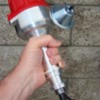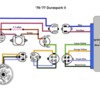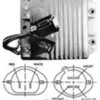Duraspark I Ignition InformationCalifornia was the only state in which Ford vehicles were equipped with Duraspark I ignitions, the rest of North America has never been familiar with this ignition. The Duraspark I ignition was also known within Ford as the high output ignition, it was more than a different Duraspark module, it was considered an entirely different igniton system than the Duraspark II ignition system. The Duraspark I ignition was utilized in all California V8 equipped applications in 1977, and limited to California 302 V8 applications in 1978 and 1979. The Duraspark I ignition module is identified by its RED wiring sealing block.
At the heart of the Duraspark I ignition was a special ignition coil having a very low primary winding resistance. The coil was also operated with no ballast resistance, therefore current flow in the primary windings was substantially increased in comparison to the primary current of Ford's standard (Duraspark II) electronic ignition system. The core of the coil was designed to accept a much higher magnetic charge from the increased current flowing in the primary windings, thus producing a substantially higher voltage to the spark plugs. The higher magnetic charge also allowed the coil to reach "full charge" more rapidly than Ford's other systems. Spark intensity was greatly increased ... especially at higher rpm. If this coil's primary winding was charged with the conventional "fixed-dwell" control utilized by the standard electronic ignition system it would overcharge at low rpm and overheat. Therefore an ignition module with a unique primary current control circuit was required to compliment this coil.
Differing from the various Duraspark II ignition modules, the Duraspark I module didn't control charging of the coil in the conventional way. The Duraspark I module utilized dynamic dwell, meaning the module constantly adjusted dwell based on current flow in the coil's primary circuit, independent of engine speed. This prevented over charging or under charging the coil throughout the motor’s rpm range. Dwell therefore varied with respect to the degrees of crankshaft rotation but remained relatively constant with respect to actual coil charging time; and the coil was properly charged throughout the engine's operating range.
The Duraspark I ignition produced the most consistent and most potent spark of any Ford ignition. This is Ford’s best ignition for igniting lean mixtures or rich mixtures, which was the purpose for its existence. The ignition will ignite mixtures the Duraspark II ignitions can’t. The dynamic dwell feature gives this module good high rpm performance too. This ignition’s design was more elaborate than the design of the Duraspark II ignition, and therefore it was more costly for Ford to manufacture (replacement Duraspark I modules cost several times the price of replacement Duraspark II modules).
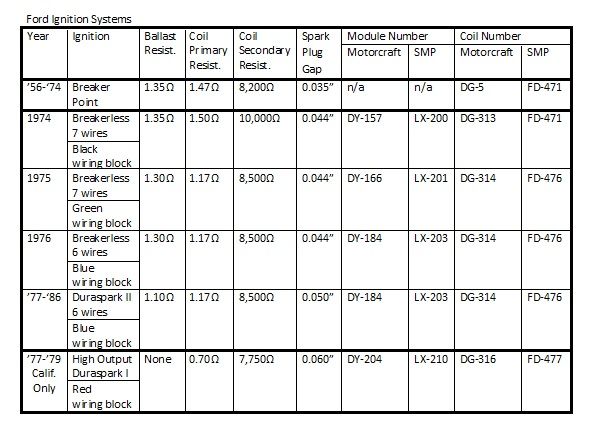
 Parts List
Parts List(1) Distributor: MSD #8477 or Ford Duraspark
(2) Duraspark II Wiring Harness: Painless Wiring #30812. Four changes must be made to allow Duraspark I parts to be used with a Duraspark II harness: (1) The Duraspark II key tab must be removed from the 4 pin connector to use this harness with Duraspark I modules. (2) The positions of the green wire and the orange wire must be reversed in the four pin connector. (3) The ballast resistor included with the wiring harness is not used for a Duraspark I application. (4) The alignment lug on the Duraspark I coil tower must be removed to allow the Duraspark II horse shoe style coil connector to slide on. It helps to have a Dremel tool.
(3) Spal FRH relay harness
(4) Duraspark I Coil: Motorcraft #DG-316 or Standard Motor Products #FD-477 (0.70 ohm primary winding resistance)
(5) Duraspark I Module: red wiring strain relief, Motorcraft #DY204, or Standard Motor Products #LX210
(6) Ignition wires - Ford Racing 9mm ignition wires plus vertical wire looms (see chart)
(7) Spark Plugs: Autolite AF32 or equivalent for motors having 9.5:1 or higher compression ratio; Autolite AF42 or equivalent for motors having less than 9.5:1 compression ratio (see chart for equivalents). Spark plugs for Duraspark I applications are gapped at 0.060”; spark plugs for Duraspark II applications are gapped at 0.050”.
Ford Racing 9mm Ignition Wires
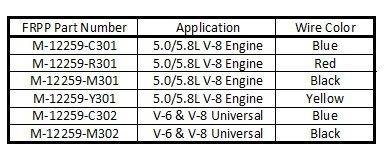
As with any 351C ignition wire kit, if the ignition coil remains mounted in the original position on the bulk head, the coil wire included with the FRPP ignition wire kit will probably not be long enough if it is pre-cut, so have a contingency plan for that wire. One contingency is to relocate the coil by mounting it on the front of the left hand cylinder head, similar to the Boss 302, using the Boss 302 mounting bracket parts. By the way, that coil wire wears out 8 times faster than the other wires.
Manage the ignition wires with vertically oriented 7mm – 9mm spark plug wire looms such as those sold by Taylor (#42502), Smoothie/Made 4 You (#5075611) or Autotrend EFI (the Autotrend looms are made of billet aluminum, manufactured in various configurations, and sold by the individual piece). These not only make the engine compartment look better, they keep the wires off the exhaust system, away from sharp edges, and help prevent cross-fire.
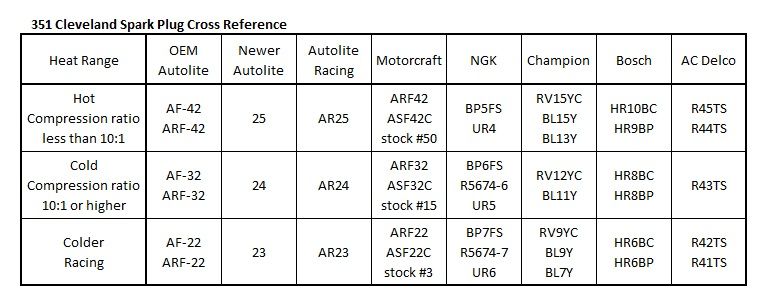 universal ignition calibration
universal ignition calibration (for Cleveland motors equipped with factory iron heads & flat top pistons)
(1) Calibrate the distributor for 20° centrifugal advance. The centrifugal advance curve should start advancing at 1200 rpm (a few hundred rpm above the motors idle rpm assuming the motors idle will be set around 800 to 1000 rpm). The centrifugal advance curve shall advance 10° per 800 rpm to 10° per 1000 rpm. If the curve starts at about 1200 engine rpm it should end at 2800 to 3200 engine rpm.
(2) Connect the vacuum advance canister to the carburetor’s ported vacuum connection. If the vacuum advance is adjustable it should be limited to about 10°.
(3) Set the initial (static) advance at 16° to 18°.
(4) 16° to 18° initial advance plus 20° centrifugal advance equals 36° to 38° total advance. The amount of advance at idle shall be 16° to 18° due to the initial advance setting, there is no vacuum advance at idle with ported vacuum.
_________________________________________
The MSD #8477 distributor is easily calibrated for a 20° centrifugal advance curve by installing the blue stop bushing and the 2 blue springs included with the distributor.
However, if you prefer to utilize a Ford Duraspark distributor, a distributor that will fit the 351C can be sourced from a 1975 through 1982 Ford passenger car or truck equipped with a 351M, 400 or 460 V8.
To calibrate a Ford distributor for a 20° centrifugal advance curve requires a 10°/15° centrifugal advance cam assembly (#C5AZ-12210-B; having a cam plate stamped 10L-15L) installed in the 10° (10L) position, and new advance springs from either Mr. Gasket (kit #925D) or Crane Cams (kit #99607-1). The Mr. Gasket kit includes one pair of springs, the Crane Cams kit includes 3 pairs of springs AND an adjustable vacuum advance canister. The Crane Cams kit is obviously the way to go as it will allow you to adjust the vacuum advance as well as the centrifugal advance.
-G







